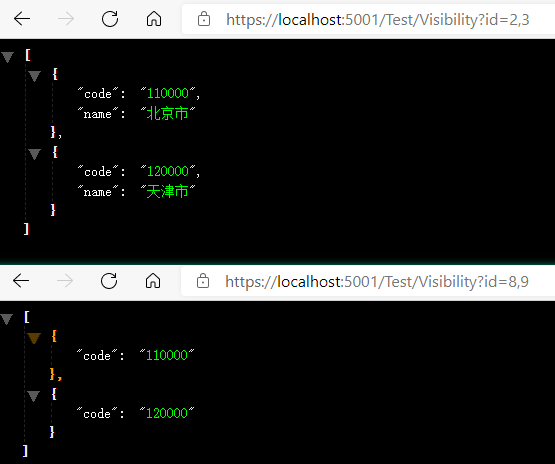通过创建动态类型 动态构建Expression Select表达式来控制Property可见性
通过创建动态类型 动态构建Expression Select表达式来控制Property可见性
项目中经常遇到的一个场景,根据当前登录用户权限,仅返回权限内可见的内容。参考了很多开源框架,更多的是在
ViewModel层面硬编码实现。这种方式太过繁琐,每个需要相应逻辑的地方都要写一遍。经过研究,笔者提供另外一种实现,目前已经应用到项目中。这里记录一下,也希望能给需要的人提供一个参考。
1、定义用于Property可见性的属性PermissionAttribute
PermissionAttribute.Permissions保存了被授权的权限列表(假设权限类型是string)。构造函数要求permissions不能为空,你可以选择不在Property上使用此属性(对所有权限可见),或者传递一个空数组(对所有权限隐藏)。
///<summary>
/// 访问许可属性
///</summary>
[AttributeUsage(AttributeTargets.Class | AttributeTargets.Property)]
public class PermissionAttribute : Attribute
{
public readonly IEnumerable<string> Permissions;
public PermissionAttribute([NotNull] params string[] permissions)
{
this.Permissions = permissions.Distinct();
}
}
2、定义Entity,给个别Property添加PermissionAttribute属性来控制可见性
Name属性的访问权限授权给3、4权限,Cities授权给1权限,Id属性对所有权限隐藏,Code属性对所有权限都是可见的。
///<summary>
/// 省份实体
///</summary>
[Table("Province")]
public class Province
{
/// <summary>
/// 自增主键
/// </summary>
[Key, Permission(new string[0])]
public int Id { get; set; }
/// <summary>
/// 省份编码
/// </summary>
[StringLength(10)]
public string Code { get; set; }
/// <summary>
/// 省份名称
/// </summary>
[StringLength(64), Permission("3", "4")]
public string Name { get; set; }
/// <summary>
/// 城市列表
/// </summary>
[Permission("1")]
public List<object> Cities { get; set; }
}
3、构建表达式
ExpressionExtensions类提供了根据授权列表IEnumerable<string> permissions构建表达式的方法,并扩展一个SelectPermissionDynamic方法把sources映射为表达式返回的结果类型——动态构建的类型。
public static class ExpressionExtensions
{
/// <summary>
/// 根据权限动态查找
/// </summary>
/// <typeparam name="TSource"></typeparam>
/// <param name="sources"></param>
/// <param name="permissions"></param>
/// <returns></returns>
public static IQueryable<object> SelectPermissionDynamic<TSource>(this IQueryable<TSource> sources, IEnumerable<string> permissions)
{
var selector = BuildExpression<TSource>(permissions);
return sources.Select(selector);
}
/// <summary>
/// 构建表达式
/// </summary>
/// <param name="sources"></param>
/// <param name="permissions"></param>
/// <returns></returns>
public static Expression<Func<TSource, object>> BuildExpression<TSource>(IEnumerable<string> permissions)
{
Type sourceType = typeof(TSource);
Dictionary<string, PropertyInfo> sourceProperties = sourceType.GetProperties(BindingFlags.Public | BindingFlags.Instance).Where(prop =>
{
if (!prop.CanRead) { return false; }
var perms = prop.GetCustomAttribute<PermissionAttribute>();
return (perms == null || perms.Permissions.Intersect(permissions).Any());
}).ToDictionary(p => p.Name, p => p);
Type dynamicType = LinqRuntimeTypeBuilder.GetDynamicType(sourceProperties.Values);
ParameterExpression sourceItem = Expression.Parameter(sourceType, "t");
IEnumerable<MemberBinding> bindings = dynamicType.GetRuntimeProperties().Select(p => Expression.Bind(p, Expression.Property(sourceItem, sourceProperties[p.Name]))).OfType<MemberBinding>();
return Expression.Lambda<Func<TSource, object>>(Expression.MemberInit(
Expression.New(dynamicType.GetConstructor(Type.EmptyTypes)), bindings), sourceItem);
}
}
上述代码片段调用了LinqRuntimeTypeBuilder.GetDynamicType方法构建动态类型,下面给出LinqRuntimeTypeBuilder的源码。
public static class LinqRuntimeTypeBuilder
{
private static readonly AssemblyName AssemblyName = new AssemblyName() { Name = "LinqRuntimeTypes4iTheoChan" };
private static readonly ModuleBuilder ModuleBuilder;
private static readonly Dictionary<string, Type> BuiltTypes = new Dictionary<string, Type>();
static LinqRuntimeTypeBuilder()
{
ModuleBuilder = AssemblyBuilder.DefineDynamicAssembly(AssemblyName, AssemblyBuilderAccess.Run).DefineDynamicModule(AssemblyName.Name);
}
private static string GetTypeKey(Dictionary<string, Type> properties)
{
//TODO: optimize the type caching -- if fields are simply reordered, that doesn't mean that they're actually different types, so this needs to be smarter
string key = string.Empty;
foreach (var prop in properties)
key += prop.Key + ";" + prop.Value.Name + ";";
return key;
}
private const MethodAttributes RuntimeGetSetAttrs = MethodAttributes.Public | MethodAttributes.SpecialName | MethodAttributes.HideBySig;
public static Type BuildDynamicType([NotNull] Dictionary<string, Type> properties)
{
if (null == properties)
throw new ArgumentNullException(nameof(properties));
if (0 == properties.Count)
throw new ArgumentOutOfRangeException(nameof(properties), "fields must have at least 1 property definition");
try
{
// Acquires an exclusive lock on the specified object.
Monitor.Enter(BuiltTypes);
string className = GetTypeKey(properties);
if (BuiltTypes.ContainsKey(className))
return BuiltTypes[className];
TypeBuilder typeBdr = ModuleBuilder.DefineType(className, TypeAttributes.Public | TypeAttributes.Class | TypeAttributes.Serializable);
foreach (var prop in properties)
{
var propertyBdr = typeBdr.DefineProperty(name: prop.Key, attributes: PropertyAttributes.None, returnType: prop.Value, parameterTypes: null);
var fieldBdr = typeBdr.DefineField("itheofield_" + prop.Key, prop.Value, FieldAttributes.Private);
MethodBuilder getMethodBdr = typeBdr.DefineMethod("get_" + prop.Key, RuntimeGetSetAttrs, prop.Value, Type.EmptyTypes);
ILGenerator getIL = getMethodBdr.GetILGenerator();
getIL.Emit(OpCodes.Ldarg_0);
getIL.Emit(OpCodes.Ldfld, fieldBdr);
getIL.Emit(OpCodes.Ret);
MethodBuilder setMethodBdr = typeBdr.DefineMethod("set_" + prop.Key, RuntimeGetSetAttrs, null, new Type[] { prop.Value });
ILGenerator setIL = setMethodBdr.GetILGenerator();
setIL.Emit(OpCodes.Ldarg_0);
setIL.Emit(OpCodes.Ldarg_1);
setIL.Emit(OpCodes.Stfld, fieldBdr);
setIL.Emit(OpCodes.Ret);
propertyBdr.SetGetMethod(getMethodBdr);
propertyBdr.SetSetMethod(setMethodBdr);
}
BuiltTypes[className] = typeBdr.CreateType();
return BuiltTypes[className];
}
catch
{
throw;
}
finally
{
Monitor.Exit(BuiltTypes);
}
}
private static string GetTypeKey(IEnumerable<PropertyInfo> properties)
{
return GetTypeKey(properties.ToDictionary(f => f.Name, f => f.PropertyType));
}
public static Type GetDynamicType(IEnumerable<PropertyInfo> properties)
{
return BuildDynamicType(properties.ToDictionary(f => f.Name, f => f.PropertyType));
}
}
4、测试调用
在Controller中增加一个Action,查询DBContext.Provinces,并用上面扩展的SelectPermissionDynamic方法映射到动态类型返回当前用户权限范围内可见的内容。代码片段如下:
[HttpGet, Route(nameof(Visibility))]
public IActionResult Visibility(string id)
{
var querable = _dbContext.Provinces.SelectPermissionDynamic(id.Split(',')).Take(2);
return Json(querable.ToList());
}
测试case:
访问/Test/Visibility?id=2,3,预期返回Code和Name属性;
访问/Test/Visibility?id=8,9,预期返回Code属性;
如下图所示,返回符合预期,测试通过!

参考文档:
[1] https://docs.microsoft.com/zh-cn/dotnet/api/system.reflection.emit.assemblybuilder.definedynamicassembly?view=net-5.0
[2] https://stackoverflow.com/questions/606104/how-to-create-linq-expression-tree-to-select-an-anonymous-type



 浙公网安备 33010602011771号
浙公网安备 33010602011771号